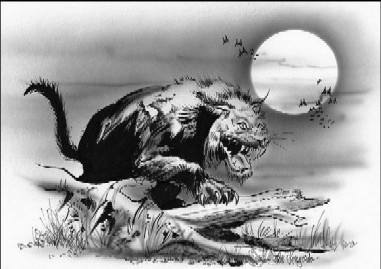Bladenboro Beast Is Back
Posted by: Loren Coleman on March 17th, 2008

As the North American warm weather develops and the two new cryptozoology television series, “MonsterQuest” and “Destination Truth” battle for ratings heats cryptid matters, it will be worth our time to notice how many media mentions are generated by these two programs.
For example, the Beast of Bladenboro article below appears to have been written because of the documentary filmmakers renewing investigations of the old stories as due to any new reports.
If the tourist development success seen in such locations as Bladenboro or ones like in Point Pleasant, we should not be surprised to see other rural towns sharing their old monster stories with willing production companies.
This beast refuses to die.
Half a century after hunters came by the hundreds to stake out Bladenboro’s big swamp, the elusive vampire cat is still on the prowl.
It graces the community newsletter from time to time and headlines Beast Week, the town’s annual celebration that leads up to a Boost the ‘Boro festival.
The Beast of Bladenboro, though a bona fide terror in its day, has been embraced by a city looking for resurgence and finding national recognition by way of its folklore.
“The beast is no longer this dreaded embarrassment or shameful thing. I think people are really excited about it now,” Hiram Hester, former chairman of the Boost the ‘Boro board, said.
The bloodthirsty shadow-dweller has found a haven in the community where it wreaked havoc in January of 1954.
The killing reportedly started on New Year’s Eve, 1953, when a pair of dogs that belonged to Johnny Vause were “torn to ribbons and crushed.”
Two more pairs of dogs were mauled, their blood guzzled by the beast, and chief of police Roy Fores told mayor W.G. Fussell about the odd goings-on.
Fussell, who often called the Wilmington Morning Star with local news items, picked up the phone. On January 5, 1954, a front-page story titled “Vampire Tendencies Found In Bladenboro’s ‘Monsters'” appeared in the Star.
The story snowballed for 10 days with reports of the beast being picked up by wire services and published as far away as Arizona.
Closer to home, Gene Norton recalled the talk in Bladenboro, even though he was only 9 years old when the beast roamed.
“I remember people talking about animals that had been killed by something that had sucked all the blood out of them,” Norton wrote in a document submitted to the History Channel for use in its upcoming “MonsterQuest” feature. “Everyone was on edge for a while as something was obviously doing this to animals, so the thought was that it might turn on people.”
Fear and frustration came to residents who lived near the beasts’ stomping grounds as well as the biologists trained to find logical explanations for unusual events.
“Normally we try to ascertain the situation, find out the details of what they think they’ve seen,” said N.C. Wildlife Resources Commission biologist Tom Padgett, who patrols District 4, which includes Bladen, Cumberland and three other counties.
“A lot of times they hear strange noises, but most sightings of whatever they think it might be are at night. And there’s usually no physical evidence; no hair, no tracks. We’re not saying the people are not seeing something, but it’s very frustrating for us as well as for the folks who are involved when there’s no physical proof,” Padgett said.
Mayor called off search
Proof, though, was secondary to the compelling stories of a blood-sucking, jaw-crushing creature roaming the small mill town.
“There were right at 1,000 hunters from across the country who came to town, newspapers came to town,” Hester said.
“It got kind of extreme. Someone killed a bobcat and the mayor said, ‘Oh, we’ve killed the beast,’ just to kind of save the people from shooting each other.”
Hester acknowledged that some human mischief undoubtedly took place at the height of the beast’s reign. But some of the reported deaths of dogs and goats could have been caused by a bobcat or coyote.
“We do have reports of people losing livestock. That’s been going on for years,” Padgett said. “Most of the time it’s feral dogs. Occasionally it’s a bobcat.
“I tell people if they have an encounter with something and they don’t know what it is, if there’s any sign there, like a track, put a bucket over it and try to contact somebody in the wildlife commission,” Padgett said.
But even Padgett, the Agent Scully-type skeptic who relies on hard evidence, won’t plant a silver bullet in the small town folklore that has become a source of pride.
“I try to be as objective as I can. With all the calls we get, there may be something out there,” Padgett said.
“Over the years we have confiscated mountain lions that people had as pets. There’s always that possibility.”by Monica Holland, “Beast of Bladenboro on the prowl” – Fayette Observer, Sunday, March 16, 2008.
Thanks to Chad Arment for the article.

About Loren Coleman
Loren Coleman is one of the world’s leading cryptozoologists, some say “the” leading living cryptozoologist. Certainly, he is acknowledged as the current living American researcher and writer who has most popularized cryptozoology in the late 20th and early 21st centuries.
Starting his fieldwork and investigations in 1960, after traveling and trekking extensively in pursuit of cryptozoological mysteries, Coleman began writing to share his experiences in 1969. An honorary member of Ivan T. Sanderson’s Society for the Investigation of the Unexplained in the 1970s, Coleman has been bestowed with similar honorary memberships of the North Idaho College Cryptozoology Club in 1983, and in subsequent years, that of the British Columbia Scientific Cryptozoology Club, CryptoSafari International, and other international organizations. He was also a Life Member and Benefactor of the International Society of Cryptozoology (now-defunct).
Loren Coleman’s daily blog, as a member of the Cryptomundo Team, served as an ongoing avenue of communication for the ever-growing body of cryptozoo news from 2005 through 2013. He returned as an infrequent contributor beginning Halloween week of 2015.
Coleman is the founder in 2003, and current director of the International Cryptozoology Museum in Portland, Maine.










It would seem the rather ordinary domestic cat might exhibit “vampiristic” tendencies. In 1936, El Reno, OK resident, Nora Lorrin, watched in shock as two cats attacked a chicken. The interesting thing was, one of the cats drank the chicken’s blood but did not eat its flesh, while the other did eat the meat but drank no blood. Of course, much like the beloved children’s classic Bunnicula, perhaps this was some sort of vampire animal. 🙂
Any carnivore could show “vampiristic” tendencies. If it is a feline of any sort, dog meat isn’t usually on their menu. I just could not believe a country boy would say that bobcats have been know to kill cows. That is either one big bobcat, or the world’s smallest, sickest and dumbest cow. The average bobcat isn’t big enough to take out anything in the “hoofed family” of animals. That is usually reserved for the lions that aren’t suppose to exist out there.
very interesting new article about bladenboro beast. thanks bill green .
SHUMWAY10973:
VERY good point.